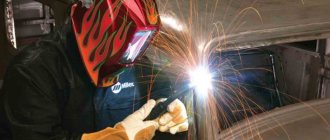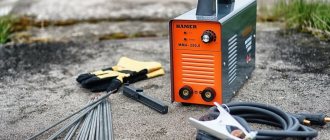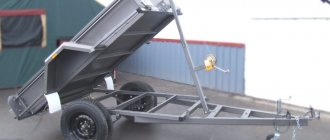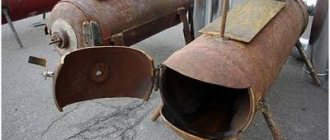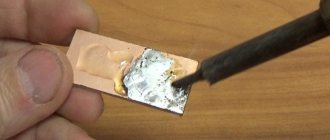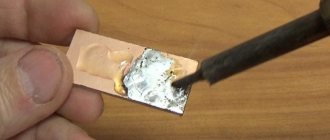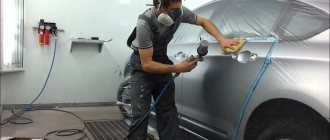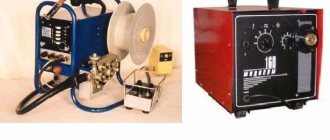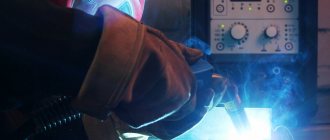The car body is constantly exposed to negative external factors: road reagents, moisture, dirt. The problem is aggravated by vibration loads. Even with proper care, traces of rust, holes, and cracks appear on surfaces. Welding a car helps eliminate these shortcomings with your own hands. The method is not suitable for removing large defects.
You need to be very careful when welding a car.
Areas most susceptible to rot that need welding
After the expiration of the period described above, the car body most often begins to rot. This may not have any impact on performance at first, but over time the rot can cause the car to break down completely.
If you purchased a car that is more than ten to fifteen years old, you need to carefully examine its body. Areas affected by rot must be repaired as soon as possible. Ideally, you need to completely change the car body, but not everyone has the means to do this.
To repair rotten body parts, nothing more than welding is used. With its help, you can repair the affected area without much difficulty. The final result is in no way inferior in characteristics to the factory state of the body.
Most often, car parts such as doors, areas under the wings and bumpers are the first to begin to rot. These places are most susceptible to pollution during operation. Also, doors are largely subject to rotting due to the human factor - the driver and passengers step on the thresholds with dirty shoes, etc. In addition to the above parts, the interior area of the trunk, precisely the place where the spare tire is located, can rot. The fact is that most drivers put the wheel there without cleaning it first.
Most often, large areas of rot can only be completely removed through major repairs. In specialized centers, professional equipment is used for this. This process is also expensive; if you do not have the necessary funds, then you can easily weld the desired area yourself. However, before you begin the repair, you need to thoroughly understand how to perform welding work, as well as which of the many welding methods to weld a car body.
Preparing and checking equipment
Regardless of which welding method was chosen, a number of preparatory operations must be carried out.
Preparation for welding a car body with a semi-automatic machine
- before starting work, the welder must make sure that the guide channel in the welding torch matches the diameter of the wire used;
- The diameter of the wire must also be taken into account when choosing a welding tip;
- The nozzle of the device is inspected for metal splashes. If there are any, they must be removed with sandpaper, otherwise the nozzle will quickly fail.
What to do before starting an inverter
- the reliability of electrode fastenings is carefully checked;
- the integrity of the insulation on the cables, all connections and on the electrical holder is checked;
- The reliability of the main welding cable fastenings is checked.
Can an inverter be used to weld a car body?
Most often, welding, in the classical sense of the word, is performed using consumables in the form of electrodes of various compositions. Using this type of welding, it is quite easy to connect anything; the process does not require a large amount of money. However, it is not advisable to repair the visible part of the body using this method, since the welded joint is very noticeable and its aesthetics leave much to be desired.
Areas around the trunk of a car, under the wings and other hidden areas can be repaired without problems using a welding inverter. In this case, it is important to use small equipment in order to easily repair areas that are difficult to reach.
When welding anything with an inverter, all safety precautions must be observed. Therefore, you should not risk the safety of the process and try to weld a hard-to-reach area. It is worth noting that the inverter is most often used for bulky, large parts.
Today, both inverter welding and semi-automatic welding are widely used to carry out repair work on a car body.
Using one or another welding method has its advantages and disadvantages. In any case, in order to work with welding machines, you must have specific knowledge. If you do not have any experience in this industry, then it is best to entrust the entire process to a person with experience behind him. When making welded joints, great attention should be paid to the level of safety, and the room should also be well lit.
Precautions before welding
Working with the device involves some risks, so the technician must follow the following rules:
- Welding is performed in boxes with screens that protect the eyes from light radiation. The minimum screen height is 150 cm.
- When working in a garage, the elimination of body defects begins after ventilation and turning on the forced exhaust.
- When welding in rooms with high humidity, a rubber suit and a mat will protect workers from electric shock. When working in a lying or sitting position, add felt.
- Before starting welding, inspect the cable and other important components of the apparatus. Only high-quality equipment and consumables are used for work.
- When welding the body, the mass of the battery is first removed, which eliminates accidental fire. When repairing parts located near the gas tank, the latter is dismantled.
- The semi-automatic device can only be moved when it is turned off. During a break, the equipment is placed on a dielectric stand.
Welding a car body with an inverter
Firstly, body repair using this method does not take much time. A professional welder will be able to complete all the work in the shortest possible time. The help of an inverter in repairing car bodies was used back in the days of the Soviet Union. Most car repair shops use inverter welding to fasten various additional equipment: a luggage rack on the roof, the so-called “kanguryatnik”, racks for additional lighting fixtures, etc.
Welding with an inverter is carried out by creating a high-frequency current. Most budget inverter welding machines are quite bulky. But expensive models can be compact in size. The main advantage of welding with an inverter is that the quality of the final welded joint is practically independent of the human factor.
You can learn how to use inverter welding equipment in just a couple of hours. However, repairing a car body using inverter welding has several disadvantages:
- Compared to other welding methods, this method is quite expensive;
- using this equipment it is simply impossible to create a seam if the thickness of the part exceeds the three millimeter mark;
- The device is very sensitive to dirt and dust; if anything gets inside its body, it will fail.
Is it possible to weld a car using inverter welding? — Metals, equipment, instructions
Currently, inverter welding machines (or inverters) are those welding machines that allow welding using electrodes.
Welding a car with an inverter: is it possible to weld a car body with an inverter?
Very often, when purchasing a used car, buyers are faced with various problems with the condition of the body. Before a transaction, it is necessary to pay great attention to even the most insignificant nuances, because they almost always have a strong impact in the future.
When buying a used car, most people only pay due attention to the technical specifications, appearance, horsepower, etc. But strangely enough, the car body is practically not checked, but only briefly examined from the outside. It is worth saying that the inside of the body is not always in the same condition as the outside.
Most experts tell us that almost all models of domestic automobile production regularly maintain the original condition of the body during ten years of operation. Foreign cars outperform our cars in this regard; their bodywork can “maintain” its factory condition for fifteen years.
Car body repair using semi-automatic welding
The bodies of most Soviet cars were created with very poor quality. After just ten years of active use, the body began to rot and break. Soviet models were much more susceptible to this process than others due to the fact that the metal was simply not painted correctly. It is commonplace, in order to save money, the paint was applied directly to the metal, without first priming the surface.
Today, there are practically no cars painted in this way, and those models that were painted in this way were transformed using semi-automatic welding. This welding method is ideal for repairing areas affected by rotting.
For semi-automatic welding, a special wire is used, it is a consumable material and can be created from various substances. Car body repair using this method is by far the most popular in our country, this is due to its versatility. Using semi-automatic welding, you can connect parts whose thickness can reach six millimeters.
Using semi-automatic welding, you can perform the following manipulations:
- create high-strength connections on the side members;
- create patches in areas susceptible to corrosion;
- straighten small dents on the body.
The semi-automatic welding machine operates using carbon dioxide. In the process of welding something, it is supplied to the work area from a special cylinder, which is under pressure. With its help, it is possible to protect the treated area from the oxidation process. This is achieved by displacing oxygen by influencing it with carbon dioxide.
The repair process using this method involves gradual melting of the metal. The welding unit has ample customization capabilities, as a result of which the chance of burning through the metal completely disappears.
One of the main advantages of this welding method is that it can be used on any type of metal. Also, if you replace carbon dioxide with argon, the welder will have access to join products made of non-ferrous metals and stainless anti-corrosion steel. To obtain a high-quality final result, it is recommended to make welded joints no longer than two centimeters, the interval between them should be at least five centimeters. Before carrying out actual repairs, the area of work must be primed.
How to cook a car with electrodes and semi-automatic?
Semi-automatic welding with a welded electrode is considered the most acceptable type of equipment relevant for vehicle repair.
Carrying out welding work on a truck or car using a semi-automatic machine allows you to reach any corner of the car to create a weld without additional difficulties. This does not require in-depth knowledge of welding or experience in performing such work.
Table of characteristics of welding wire.
In technical terms, a semi-automatic welding machine is designed quite simply: it uses the same current converter as other types of similar equipment; only the current consumables are specific.
Welding with a semi-automatic unit is performed using welding wire with a diameter of 0.2-2 mm, as well as carbon dioxide.
Often the wire is coated with copper to ensure good electrical contact. And carbon dioxide is necessary to prevent oxidation processes, since it does not allow the molten metal to come into contact with oxygen.
Since the welding process of the machine uses carbon dioxide in a cylinder, the semi-automatic machine also requires a reducer to reduce the pressure. The optimal value can only be obtained if such a device is properly configured.
On a note! A semi-automatic machine for welding cars at a service station allows you to edit both the current strength and the feed speed of the welded wire. Therefore, it is possible to achieve precise adjustment of the unit, which in turn will make it possible to create almost invisible to the eye, but very strong welds on the surface of the vehicle body.
Sometimes service station workers or private owners use a special welding wire instead of carbon dioxide, which, although it does not have a copper coating, contains a special flux inside.
The powder allows welding of the exhaust system and car body without gas supply. It is impossible to use standard wire under such conditions, because it will burn without gas.
Separately, it is worth noting the welding work to eliminate defects on the car muffler. Only an experienced craftsman can perform this task using electric welding and only by spot welding without moving the electrode.
It is better for an inexperienced craftsman to weld car mufflers with an inverter. And if you plan to replace this part of the car soon, then more economical cold welding will suffice for a while.
Tips for repairing a car body using DIY welding
It is quite difficult to connect parts made of very thin metal. To do this, it is better to use the services of a professional, since you will most likely simply deteriorate the quality of the metal yourself.
First, you need to conduct a detailed inspection of the car body to understand which areas need repair. Also, with the help of a careful inspection, you will be able to understand whether you need a major overhaul or can get by with a small local one.
A major overhaul involves performing full-scale repair work, which most often involves replacing a body part completely. If you have all the necessary equipment and experience behind you, you can easily carry out both local and major repairs to the body of your car
Welding work is carried out to repair damage or eliminate corrosion. There are several ways to accomplish this task. In this list, a special place is occupied by welding a damaged car body with an inverter. This method ensures high-quality connection of parts and allows you to reach hard-to-reach areas. But inverter welding machines also have negative sides, so such devices are recommended to be used in certain cases.
Main characteristics of the equipment
An inverter is a welding device characterized by high performance. When repairing damage and fastening parts, the car is welded using electrodes. The disadvantage of this method is the presence of visible seams. The device's current conversion frequency varies from 30 to 40 kHz. Despite its power, the unit is compact in size and weight.
There are a number of advantages when working with an inverter:
- the device quickly heats the metal;
- equipment performance does not depend on the stability of the mains voltage;
- the device is 20% economical in terms of electricity consumption;
- low rate of molten metal during the welding process;
- ease of use.
Both car service workers and people without professional experience can cook a car with an inverter. Training to use the device takes a week. The disadvantage of the equipment is its high cost.
Precautions for welding
- All welding work is carried out only in dry overalls made of non-flammable materials, gloves and a protective mask. If welding is carried out in a room with a metal floor, it is mandatory to use either a rubberized mat or rubber galoshes;
- the welding machine, regardless of its type, must always be grounded;
- when inverter welding, special attention should be paid to the quality of the electrode holder: good electrode holders can withstand up to 7000 electrode clamps without damaging the insulation;
- Regardless of the type of welding machine, it should always use automatic switches that independently break the electrical circuit when no-load current occurs;
- The room in which welding is performed must be well ventilated. This will avoid the accumulation of gases released during the welding process and which pose a particular danger to the human respiratory system.
Features of inverter welding
To use the inverter, you will need to connect through a standard outlet to a 220 Volt power supply. Car body repairs are carried out in the presence of metal elements with a cleaned surface. The quality of the seam depends on the brand and diameter of the electrode. For domestic purposes, a suitable option is welding with an electrode with a diameter of 2 to 5 millimeters. This is enough to ensure the creation of reliable patches.
The main advantage of the device is the ability to weld large parts. The device creates a seam on metal up to 3 millimeters thick. The manufacturer placed a special table on the surface of the inverter. It indicates the permissible current values. This value is set independently based on the dimensions of the electrode and the part being welded.
The inverter provides high quality seams and is mainly used for body welding. This device is also used to create welds at joints:
Body finishing
After completion of electric welding, perform the following steps:
- Clean welded joints from slag. This reduces the likelihood of oxidation of metal elements. To treat hidden places, use an iron brush. Open areas are sanded with a grinder and a special wheel. A sander with a burr is suitable for cleaning hard-to-reach areas.
- Degrease treated surfaces by wiping them with solvent. After this, the parts are coated with an anti-corrosion agent or acid primer. The best option is epoxy putty, which protects surfaces from moisture and air. It aligns the welded joint. The composition is applied in a thin layer and left for a day. You cannot dry the putty with a hairdryer.
- Re-treat the surfaces with sandpaper. Apply the second and third layers of putty. Prepare the body for painting.
We recommend reading Methods for welding gates at home
Seam sealant for cars is used to protect connections in hidden places. It is leveled and painted. The sealant is applied using a pneumatic sprayer with a plastic nozzle.
Inverter selection
Inverter devices boast portability. But the quality of the seam depends on a number of indicators, one of which is a uniform supply of voltage. The selection of a suitable device is based on a number of indicators:
- how resistant the device is to working with unstable voltage - the permissible protection factor specified for the device should be from 20 to 25%;
- permissible temperature during operation – from –40 degrees Celsius to +40 degrees Celsius;
- electrode diameter - depends on the thickness of the parts being welded (No. 2 - for thin elements, No. 4 - for components with large thickness).
In the absence of a device that meets the necessary characteristics, it is quite difficult to achieve reliable fastening of the weld.
On some models, the following systems are listed as additional features:
The device may also contain other functions that allegedly allow you to achieve a seam of higher quality than when using analogues. In fact, the additional features are a promotional ploy from the manufacturer, aimed at inexperienced users. Almost all modern and domestic welding inverters are a priori equipped with such functions.
Preparatory work
To start the inverter, a connection to a standard electrical network is used. You must first check whether the electrical wiring is able to withstand the equipment load with an indicator of 16A. If necessary, the device is connected to the vehicle battery.
The inverter turns on step by step:
- a black clamp is connected to the negative terminal;
- the red clamp is connected to the positive terminal;
- additional elements are attached to the welding machine;
- the device starts in test mode.
If a 24 V network is freely available, you cannot work with a 12 V device on it. Only one device can be used at a time.
The car is cleaned of dust and dirt. If such a need arises, components that complicate the work are removed. The humidity level in the room must be reduced to a minimum.
Step-by-step instructions for welding the body
An inverter welding machine allows you to connect parts with a thickness of 0.8 millimeters. The maximum thickness of machine elements should not exceed 6 millimeters. Before welding the car body, it is necessary to determine the scope of work and close the parts of the body that will not be welded.
If welding is used to eliminate corrosion with your own hands:
- part of the metal damaged by corrosion is cut off, or the parts are completely removed;
- the edges along which the cut passes are primed;
- After processing using an inverter, individual pieces of metal or entire parts are welded.
If new elements are attached to the surface, welding with an inverter should be done using the electrode step-by-step method:
- the length of the seams is two centimeters;
- the interval between seams does not exceed six centimeters;
- After passing along the entire perimeter of the part, full welding is performed.
This system allows us to ensure high strength and rigidity of the weld. To process the seams after welding, you will need a grinder. If sanding and painting work is not carried out, the mount will quickly become unusable.
When welding in stages, you should take breaks necessary to cool the hot metal. The duration, depending on the thickness of the parts, can be several hours.
How to treat the body after welding
After completing the repair, it is necessary to clean the welding seams from slag, since the metal underneath quickly oxidizes. In areas hidden from view, a metal brush is sufficient. In open areas, the body is processed after welding using a grinder with a grinding wheel or a flap attachment. To clean hard-to-reach seams, use a grinding machine with a burr.
Cleaned surfaces are degreased with acetone or gasoline, then treated with an anti-corrosion compound or acid primer. Epoxy putty is used to protect against corrosion. Thanks to its dense structure, it reliably protects the metal surface from contact with moisture and air and is used as a leveling layer.
After applying a thin first layer, it is left to dry for a day. You cannot use a hairdryer to speed it up, because after the top layer dries, the putty inside will remain damp, since the moisture has nowhere to evaporate. Scores are then applied to roughen the surface using 120-grit sandpaper. After applying 2 - 3 layers, preparations for painting are made.
Automotive seam sealant is used to protect seams that are invisible from the outside in easily accessible areas. If necessary, it is smoothed with a spatula and painted. The sealant is applied to hard-to-reach places using a pneumatic sprayer through a plastic tube.
After welding work, it is necessary to treat the body against corrosion
Means of protection
The welder working with the inverter must ensure his own protection while performing the task. This condition is met using:
- masks;
- gloves;
- fireproof overalls.
Protective equipment should cover the body as much as possible during welding. It is necessary to ensure that there are no folds or pockets on the clothing where hot or molten metal particles may fall.
Without protective clothing it is impossible to ensure a sufficient level of safety, so you should not take risks if there is no protective uniform. It is also recommended to have a fire extinguisher or a container of water in the work area in case of fire.
The car body is an important part of the vehicle, like other components or parts. The body is at risk, being a buffer in contact with the external environment - the inevitable mechanical impact of surrounding objects, other vehicles and objects in road accidents is guaranteed to lead to breakdowns and disruption of the shape of parts and loss of external attractive appearance. Don’t forget about the aggressive influence of the environment - moisture, dirt and salt cause corrosion spots and cracks. In all of the above cases, car body repair is required.
Requirements for welding a car body
Welding a car body is a labor-intensive process, be it arc, spot or other type of welding. In any case, it requires a high-quality welding machine for automotive body work and a highly qualified welder - only this combination guarantees a satisfactory result. Lack of proper experience and a good welding machine does not allow you to achieve an accurate and thin seam. Body welding work should be carried out in a specially equipped room, where there is a connection point to the network with the appropriate parameters of frequency, voltage and current, a gas source, etc. Welding a car body with your own hands is possible only in simple cases and for body repairs in places where the aesthetics of the seam is not so important.
A professional approach to body processing in an equipped service station allows you to obtain a weld seam with the necessary criteria:
- the type of seam is selected depending on the location of the damage;.
- taking into account the characteristics of the metal, the type of welding is selected;
- welding repair method - gas, manual arc, semi-automatic, laser - is selected individually in each case.
Welding with inverter
Choosing an inverter is a good answer to the question of which welding machine to weld a car with. It is not difficult to deal with, so a do-it-yourself car repair welding machine in the form of an inverter is the most suitable option. The inverter has high performance.
Welding with a car inverter has the following advantages:
- rapid heating of welded surfaces;
- independence from the power grid;
- ease of arc ignition;
- economical electricity consumption;
- a small number of defects;
- ease of use.
To use it, you will need a 220 W power connection. You can start welding with an inverter only after thoroughly cleaning the surfaces to be joined. Using an inverter, you can also apply patches to problem areas.
The ease of use of welding with a car inverter is combined with high quality results. Is it possible to weld a car using inverter welding? The answer is ambiguous. Of course, it is possible, but it is advisable to do this by welding thick parts, which, in particular, include the bottom and side members. In addition, the considerable cost of this equipment should be taken into account. You can learn how to weld a machine using inverter welding by carefully studying the operating instructions supplied with the device.
To choose the right welding machine for your car in the form of an inverter, you should consider the following points:
- Resistant to voltage surges.
- Temperature limits at which equipment welded using an inverter can be used.
- Diameters of electrodes used in the inverter.
Electrodes with a diameter of two millimeters are used for thin parts - on the wings and doors, and with a diameter of four millimeters - for work on the body.
Before starting automotive welding work, you should pay attention to the humidity of the room where the process will take place and ensure its minimum value. This will reduce the chance of water droplets getting into the seam when welding, which can cause small pits and damage to the seam. In case of significant corrosion damage, the edges of the future seam are treated with a special primer.
Welding a car with an inverter is used if it is necessary to carry out repair work in the trunk area, under the wings, as well as other hidden areas of the car.
It is advisable to choose an inverter with continuous adjustment. When welding thin-walled car parts with an inverter, the polarity should be reversed. This will help avoid burns of parts and changes in their shape.
What type of welding should I use to weld the body?
As stated above, the choice of which welding and which materials are suitable for welding a car body should be done by professionals, as well as which apparatus to choose to implement the process. The car body is made of low-alloy steels with a small titanium content or carbon steels with a carbon content in the range of 0.08 - 0.14%, and such steel, with an average thickness of about 0.8 mm, is excellent for stamping and is resistant to strong tension. As for the types of welding repairs, the specialist chooses from the following range:
- manual arc welding using a multi-station welding rectifier of the “VDM 1202” type or its equivalent with electrodes with a diameter of 1.6 mm of the UONI 13/45 brand, the weld position is lower;
- gas welding of a car body is performed with a gas torch with an acetylene-oxygen flame and filler wire with a diameter of 0.8 mm, brand Sv-08G2S;
- semi-automatic welding of a car body is also in high demand - it will require a carbon dioxide cylinder and wire with a diameter of 0.8 mm of the Sv-08G2S brand. However, you can weld semi-automatically and without gas, using cored wire or flux-cored wire.
Is it possible to weld a car body with a welding inverter?
The inverter body welding machine with high frequency electric current is used to weld bumpers, additional frames, rear and front winches, bull bars and even fog lights if the customer wanted to place them on the roof of the vehicle. The basic advantage of welding a car body with an inverter is high speed - the work will be completed in the shortest possible time. The inverter has been actively used in the process of creating welds on a vehicle since Soviet times, however, only in areas of the body that do not make any claims to the aesthetic appearance. The resulting seams are reliable and durable, but only on metal with a thickness of over 3 mm. To obtain a high-quality seam with an inverter, it is important to carry out the procedure in a clean room - moisture and dust entering the housing will inevitably affect the quality of the seam.
Semi-automatic body welding
Which device to choose for underbody repair? A semi-automatic welding machine for body work is optimal for making patches on rust-affected areas of the body. Semi-automatic body welding is performed using a special wire and has deservedly received the title of the most universal means of body repair today. This method allows you to connect metal sheets with a thickness of 0.8-6 mm. Regarding the types of work performed using a semi-automatic machine, it is important to note the following:
- reliable connections on the side members;
- patches in place of corroding metal;
- restoration of the shape using a welding machine in place of ordinary dents.
In addition to connecting the parts, during the welding of the parts, the contact point gets rid of oxygen, and the car body gradually melts, but since semi-automatic welding of the car body is carried out under the control of the operator, the iron does not burn.
Which welding machine is best to choose for creating connections on any type of metal? Of course, this is a semi-automatic welding machine. Indeed, if you use argon rather than standard carbon dioxide for the welding process, then it is also possible to weld non-ferrous metals such as aluminum and stainless steel.
Do-it-yourself welding
Welding car parts can be done even by a home craftsman. Auto welding is possible if there is space to carry out this process and the enthusiasm of its owner. Is it possible to weld a car using conventional welding? Of course, because the main parts of the car are made of metal.
Of course, welding a car will require purchasing the necessary equipment, consumables and tools. You should also consider secure fixation. It should be noted that welding thin-walled parts is more complex and requires knowledge of the intricacies of this process.
The first question for a welder to carry out repairs on his own is what welding machine can be used to weld a car. It is convenient to do this with semi-automatic devices and inverters.
For auto repair, a welding machine may have its advantages and disadvantages. Before choosing a welding machine for a car, you should familiarize yourself with their characteristics and application features. The selected welding machine for a car will help eliminate all existing shortcomings and allow you to use your car for a long time.
Features of welding a car body with an electrode
Manual arc welding
allows you to weld thin-layer metal, but to obtain a neat seam you need not only a welding machine for body work, but also experience. If you have no experience using a welding machine yourself, you can only patch the rusted through areas of corrosion on the bottom - to perform such operations, you can take any materials, the main thing is that they meet the requirements for thickness and reliability. The rest should be left to professionals. This option for connecting metal parts is the oldest and most reliable, and at the same time the most versatile. Moreover, this option can be used for any spatial location of the weld, even in places with limited access. And the wide selection of manufactured electrode grades makes it possible to weld a wide variety of steels - both carbon steels of ordinary quality and high-quality steels with different contents of alloying elements. In this case, the quality of the seam directly depends on the qualifications of the welder, and in general the productivity is lower compared to other welding technologies, but the relevance of a manual welding machine with electrodes is not reduced due to the simplicity and transportability of such equipment.
For obvious reasons, welding a car body with your own hands is cheaper, but not of better quality, especially if the semi-automatic welding machine for body work leaves much to be desired. Having decided to choose a machine for body repair, a qualified specialist will take into account the chemical composition, the thickness of the metal, the location of the welded parts, so that the condition of the thresholds after welding will please the car owner for many years. Indeed, if you have a high-performance welding machine for body work and competent specialists in an equipped room, then it will not take much time to repair the body. So don’t skimp on your car and your own safety - entrust your vehicle to professionals who have everything you need for auto body work.
Car welding instructions
The procedure for restoring the body or other parts of the car depends on the chosen method.
Using the Electrode
This method is used in the absence of high requirements for the aesthetic qualities of the seam . Choosing the right electrode for the type of metal helps ensure a strong connection. It is recommended to use inverter equipment that supports a stable arc. The reliability of the weld depends little on the experience of the welder.
To reduce the likelihood of joint deformation, welding work is performed in the following sequence:
- Create potholders.
- Apply short stitches in 5 cm increments.
- Weld the part with a continuous seam.
After each step, take a short break to allow the metal to cool. Welding thick automotive parts can take 3-5 hours. Forced cooling is prohibited: it greatly reduces the strength of the connection.
Semi-automatic device
To weld with such a unit, you will need copper-plated wire with a diameter of 1 mm, coarse sandpaper, a gearbox, and carbon dioxide.
We recommend reading: How to weld a car muffler yourself
The work is carried out as follows:
- The edges treated with abrasive material are installed as close to each other as possible. For fixation, self-tapping screws, bolts, and clamps are used.
- Set the required current strength and supply speed of the consumable material using the regulators located on the device body.
- The gas cylinder is equipped with a reducer and a hose. Unscrew the nozzle and remove the tip from the burner.
- Install a coil of wire into the apparatus. The free end is inserted into the feed mechanism. Place the tip on the wire and return the nozzle to its place.
- The polarity is set: the holder is connected to the plus, the burner to the minus. The opposite option is installed when using wire that is not coated with copper.
- Connect the unit to the electrical network. The burner is brought to the area to be treated. Press the button to start the supply of gas and filler material. To form a long seam, you need to weld 3-4 points. Next, stitches 2-4 cm long are made.
- Wait for the metal to cool, weld the distances between the tacks.
SAIPA-165
Inverter Features
The popularity of such devices is explained by their compact size, low power consumption, the use of new current conversion technologies, and an expanded range of modes. The unit can operate in a wide range of input voltages. The arc is excited quickly and burns stably.
Many people starting work for the first time wonder whether it is possible to cook a car with an inverter. The process is not much different from standard welding, but the seam is of lower quality - uneven, thick.
The metal overheats, which can cause it to become deformed. Inverter technology is used to repair hidden places, such as the bottom.

